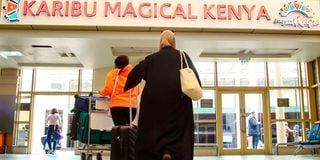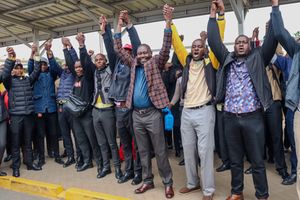
Passengers exit with their valuables at the International Arrival Terminal 1A at JKIA during a media tour of the passenger clearance process at the airport on November 7, 2023.
A recommendation to benchmark Nairobi’s Jomo Kenyatta International Airport (JKIA) on Atlanta City International Airport and, position it as Africa’s aviation hub has been spectacularly turned into a cash-cow by senior officials in successive governments since it was mooted in 1996.
In the intervening period, Ethiopia lurched onto a similar idea and is expanding its Bole International Airport Mega City Project to grow its passenger numbers to 110 million per year and undermine Nairobi’s geographic advantage in global trade.
This comes as Kenya is once again caught up in yet another controversial attempt to boost its most-prized airport – this time involving India’s multinational conglomerate Adani Group. Aviation experts now warn Kenya will pay heavily for dithering and corruption as Ethiopia cruises to aviation infrastructure expansion.
The JKIA Greenfield project was at conception nearly 40 years ago billed as a game-changer in Africa’s aviation industry. Already, the Addis Ababa airport tops Africa with 22 million passengers per year compared to JKIA’s seven million.
As corruption remains entrenched in infrastructure projects, a former managing director of Kenya Airways and head of Kenya Civil Aviation Authority (KCAA), Julius Okara, has raised fresh concerns that the land that had been allocated for JKIA expansion has over the years been stolen.
Mr Okara, who is an engineer, says the JKIA Greenfield project has been in abeyance for more than 30 years and the current standoff provides a peek into how an infrastructure project conceived for Kenya by former US Permanent Representative to the United Nations Andrew Young was turned into pork barrel spending.
Young on a visit to Nairobi prior to the 1996 Olympic Ganes, described the project as an economic turning point for eastern Africa, and Kenya in particular.
In the latest move justified by President William Ruto’s administration as an option to make JKIA more competitive and efficient, stakeholders have raised questions on the transparency of ongoing negotiations to hand over the airport to Adan Airport Holding Ltd for 30 years.
The union representing the Kenya Airports Authority workers has launched a legal challenge and threatened strike even as government officials signal their intention to continue with the process.
At issue is the single sourcing of contractor, job details and allegations of intellectual property rights violations by Adani Airport Holding Ltd, which will be implementing a design that is now their own, according to union officials.
Just months after he took office in 2022, President Ruto announced plans to discharge loss-making State corporations, including national carrier Kenya Airways.
There seems to have been a change of heart about this and the airline recently made a Sh513 million net profit “helped by reduced exposures from foreign currency fluctuations and the restructuring of its loans by the state.” The JKIA greenfield masterplan was modelled on ambitious expansion of the Atlanta City airport in the United States.
The concept was shared with Kenya by Mr Young, who had been sacked by former US President Jimmy Carter in far-reaching reorganisation of his government. After he quit the Carter administration, Mr Young was elected mayor of Atlanta.
He immediately set out to make Atlanta Hartsfield-Jackson International Airport the hub of aviation of the southern states of the US. He embarked on the expansion of the city’s airport capacity from five million to 40 million per year.
As a harbinger of the economic reward to accrue, Mr Young campaigned and succeeded in securing a deal to host the 1996 Olympic Games in Atlanta, Georgia.
It was during these promotional tours that Young landed in Nairobi and met President Daniel arap Moi, says Mr Okara.
“At one point in my meetings with Mr Young, the Kenyan engineer says he was asked sobering questions: ‘Why are you people looking for oil? If only you can change your airport into a regional aviation hub, the economic reward would be a million higher than oil benefits.’
The American explained that like Atlanta, Nairobi’s location was a big advantage.
Mr Okara says he was told: “If you can upgrade the airport to a point where you have three runways so that it becomes a hub like Dubai to enable you to move huge passenger numbers per year, you would not need oil.
You can come and look at what I am doing in Atlanta: in 10 years from now Atlanta will be handling over 60 million passengers per year. You can imagine how much I will be collecting per airline, per passenger and other services like hotels. You don’t need oil. Make this airport a regional hub and you will shift passenger flights from Dubai and East Asia to Nairobi.”
It was a challenge inspired the plan to expand JKIA.
Latest data show that Atlanta International Airport has surpassed the initial projection of 60 million passengers per year and is currently handling 104.7 million passengers according to 2023 international aviation data while JKIA, over the same period raised its numbers from just below a million in 1996 to roughly seven million currently.
To underline the seriousness of concerns KAA trade union, President Ruto convened a meeting with KAA and Kenya Airways trade union officials last week in an attempt to dissuade them from pressing ahead with the legal action and strike.
This is after it emerged that the trade union members were, among other things, angry at the running. The meeting ended in a stalemate. State House spokesperson Mohammed Hussein neither responded to calls or text inquiries about the meeting and allegations on the running of JKIA.
A case filed in court challenging the legality and constitutionality of the contract to Indian firm, Adani Holdings, has also inadvertently brought to the fore the evolution of the project that was conceived in 1996 in the wake of World Bank and International Monetary Fund (IMF) on African governments to divest from aviation, which Kenya via the ministry of transport and State-funded KCAA contested and retained a 51 per cent stake in a corporation that was deemed strategic to the nation’s economic, security and political interests.
Mr Okara says the project should have been completed in 2010 and raised traffic capacity to 40 million passengers per year. Kenya Airways head of communication Henry Okatch distanced the airline from questions on KAA, saying “We’re not involved in what is happening at KAA. We are distinct entities.”
In another response, the airline downplayed the business threat posed by Bole International Airport expansion.
“KQ’s focus is on our operations and network planning efforts in line with our expansion strategy and Project Kifaru 2.0. We therefore are keen to grow JKIA as a hub for Kenya Airways’ operations,” says the airlines communication officer Vivienne Atieno Namadoa.
In addition, Ms Atieno says, “KQ is not facing a downturn in business. Our growth in passenger numbers has been increasing year on year since 2022. During our half year results that were released our passenger load factor had increased to 82.5 per cent, with our Available Seat Kms (ASK) going up to 11.8 per cent from 8.5 per cent in the same period for previous year. Our focus on network planning, which includes any grounded flights, changed routes et al are part of our overall expansion strategy.”
Former African Union Vice Chair Cyrus Mwencha blames the KAA and Kenya Airways imbroglio on laissez-faire in the executive. Mr Mwencha recalls that he was instrumental in enabling KQ to fly into the 21-member Common Market for Eastern and Southern Africa (Comesa) when he served as the secretary-general of the regional economic bloc.
The idea, he says, was to leverage the planned expansion of JKIA to dominate the African skies.
“I tried my best but there was no reciprocity in the government. A good idea was killed by State machinery and there may be no recovery for Kenya’s aviation industry after losing the advantage to Ethiopia,” Mwencha told the Weekly Review recently during a workshop on African politics in Nairobi.
The bad news for Kenya does not stop there. A report published in the July 17 edition of Ethiopian newspaper, The Afro Times, gives details that make JKIA to look like a neglected football pitch. Quoting Ethiopia Airlines chief executive Mesfin Tasew Bekele, the paper reported that the expansion of the Bole international Airport, dubbed Mega Airport City and located some 39 kilometres away from the current location, is set for completion in 2029 and will be the “busiest in Africa.”
“Scheduled for completion in 2029, the first phase of the Mega Airport City will handle 60 million passengers – almost three times the current capacity of Bole International Airport, Africa’s busiest airport in 2022. This phase will include a 1.1 million square metre terminal with extensive passenger and airline support facilities, as well as over 100,000 square metres dedicated to cargo and airport support infrastructure.
” The Afro Times reported. Mr Okara, who had been given the nod by Mwai Kibaki to spearhead the project implementation as part of Kenya’s economic lift-off Marshall Plan, Vision 2030, says the reason President Uhuru Kenyatta jettisoned the Sh64 billion project after he came to power was linked to integrity questions on the sourcing and costs involved.












